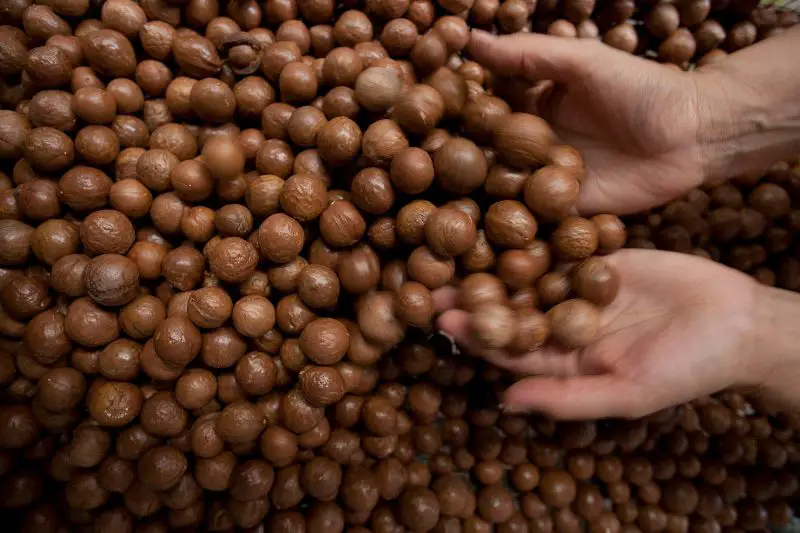The success of macadamia nuts farming heavily relies on how it is harvested. Macadamia trees are vulnerable to a lot of elements including pests, diseases and physiological damage among others. The kernels are too brittle thus if not handled properly can be crushed resulting in lower yields. Macadamia nuts can also mould in storage or be attacked by rodents and insects. They can also be crushed during different mechanical processes. Harvesting macadamia nuts requires therefore great precision.
Table of Contents
Harvesting Time
Timing is a key element in harvesting macadamia nuts. This is because macadamias are susceptible to damage if left unpicked for a lengthy period of time. Identifying ripe macadamia is quite easy. The husks dry out, lose their tackiness and gradually change from bright green to brown. In addition, they shrink and split open, the spit edges turn brown revealing the brown nut inside. The key identifier for harvesting macadamia nuts are the fallen fruits. Macadamia nuts fall to the ground when they are fully mature. The nuts should be picked within 2 to 3 days after falling to prevent damage. In humid climates, if harvesting is delayed the nuts can start to germinate or be attacked by mould. In dry temperatures, harvesting macadamia nuts can be extended to every 2 weeks. However, it is important to understand that once on the ground, the nuts are vulnerable to physiological deterioration and damage by rodents and insects.
Macadamia Nuts Harvesting method
Harvesting macadamia nuts is often a manual process. The nuts are hand-picked directly from the ground. Macadamia nuts fall to the ground when they reach full maturity. It is highly unadvisable to harvest fruits directly from trees as that is when they are fully mature, hence the need to harvest from the ground. The area beneath macadamia trees should be cleared of grass, old leaves, branches and other debris at all times to reduce damage and improve efficiency. The size of the cleared area should be about 1.5 times the size of the tree canopy. Clearing beneath trees allows farmers to identify the nuts quite easily thus do not run the risk of stepping on them and crushing them whilst harvesting. Harvesting macadamia nuts manually is laborious and time consuming. Therefore, some farmers make use of mechanical harvesting methods to fasten the process. The downside of using mechanical means of harvesting macadamia nuts is that the chances of yields lost through collection of immature nuts are increased. Immature fruits are more likely to fall when the trees are shaken, thus are denied the opportunity to reach full maturity.
Dehusking Macadamia Nuts
Macadamia nuts have a fleshy or fibrous outer covering known as husk. This layer should be removed within 24 hours of harvesting macadamia nuts. The removal of husks prevents deterioration from sweating and overheating. Delayed dehusking can have a negative impact on nuts flavour. It should be done prior to drying to allow a faster and more efficient drying process. It is important to wash the nuts soon after removing husk. Washing can be done manually through hand washing in tubs or by machine washing in cylindrical drums.
Grading Macadamia Nuts
After harvesting macadamia nuts, they should be graded according to thickness and texture among other aspects. This is achieved by either by hand picking or use of suction machines. Grading allows efficient drying, especially for farmers who use mechanical drying methods. Imperfect, faulty and broken nuts are removed during this process.
Drying Macadamia Nuts
Drying is an important aspect of harvesting macadamia nuts. The two methods of drying macadamia nuts are; sun drying and use of mechanical dryers. When using mechanical dyers, take careful note that temperatures do not exceed 60oC as this can result in internal browning and discoloration. Mechanical dryers have an output range of about 1 to 7 tonnes for drying time of 2 to 24 hours thus are much more efficient. Sun drying takes a longer period of time to complete the same task. Sun drying demands 2 to 3 days of continuous sunny weather and up to 2 to 3 weeks in inclement weather. Drying is accomplished when the kernels can make rattling sounds in the shells or broken rather than bent with the finger. Note that freshly harvested nuts should not be immediately exposed to the sun as they might crack giving access to insects during storage.
Cracking/Shelling
Cracking, also referred to as shelling involves the extraction of kernels from the fruit. For cracking to be done effectively, macadamia nuts should have a moisture content of about 1.5%. The process of shelling can either be done manually or mechanically. Harvesting macadamia nuts by hands is a laborious and time consuming procedure. Macadamia nuts have very hard casings that are generally hard to crack. Hence, most farmers use rotating steel rollers, shelling machines and nut crackers. It is important for farmers to be aware that mechanical cracking machines result in increased yield losses. This is because of the varying differences of thickness and texture. As a solution, macadamia nuts must be graded before being fed into the machine.
Macadamia Nuts Storage
This is the final stage in harvesting macadamia coffee. The harvested macadamia can be stored for several weeks provided they are kept cool and dry. Prior to storage, the nuts should be stored in airtight bottles. Unshelled macadamia nuts are normally stored in silos. They are kept in a range of batches based on size and storage time among other factors. Silos should have sufficient airflow. Although macadamia nuts last longer in storage, infestation can eventually develop. Cold storages are usually used for a long-term storage so as to maintain freshness. The cold storage temperatures should be roughly 12oC.
Macadamia Nuts Yield
Macadamia yields vary with climate, seed variety and fertility of the soil. None the less, a well natured orchard with roughly 132 trees per hectare yields an average of 3.5 to 4 tonnes of in-shell nuts per hectare. Each tree produces approximately 12 to 13kg of nuts at maturity. A significant amount of the yield is however lost to poor harvesting practices.
Harvesting macadamia nuts should be done with caution as they have brittle kernels which can easily be damaged when mishandled. As a matter of fact, most crops lose the most produce during harvesting and macadamias are not an exception. Strict adherence to proper harvesting procedures should be practice in order to avoid unnecessary losses.

